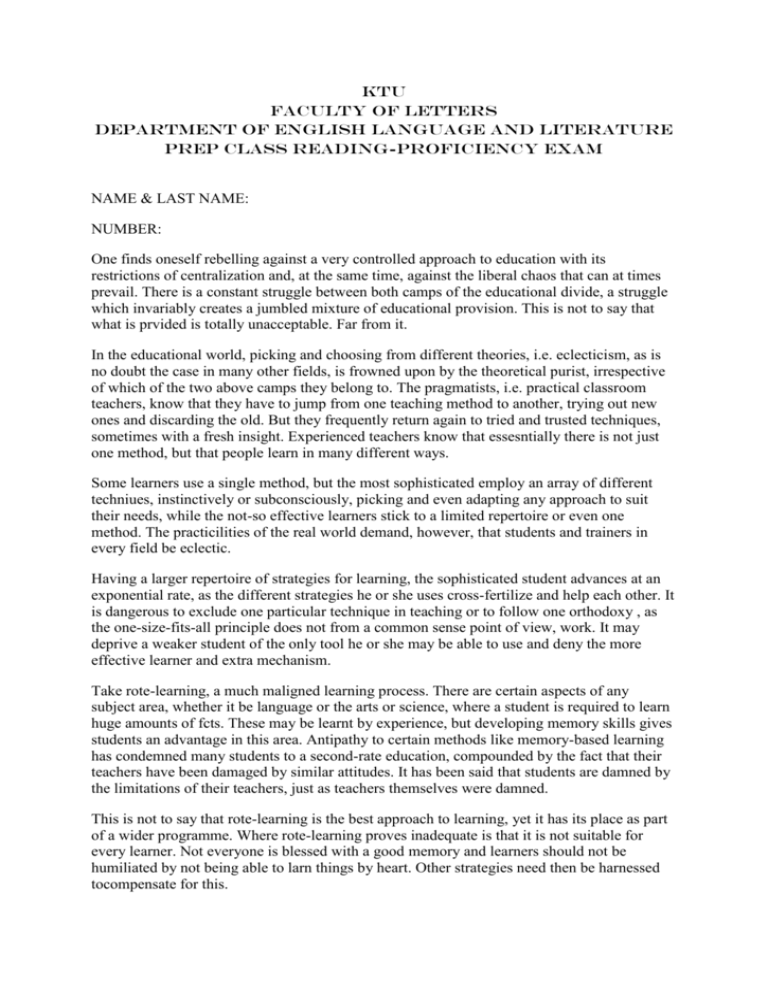Sample Reading Exam
advertisement

KTU FACULTY OF LETTERS DEPARTMENT OF ENGLISH LANGUAGE AND LITERATURE PREP CLASS READING-PROFICIENCY EXAM NAME & LAST NAME: NUMBER: One finds oneself rebelling against a very controlled approach to education with its restrictions of centralization and, at the same time, against the liberal chaos that can at times prevail. There is a constant struggle between both camps of the educational divide, a struggle which invariably creates a jumbled mixture of educational provision. This is not to say that what is prvided is totally unacceptable. Far from it. In the educational world, picking and choosing from different theories, i.e. eclecticism, as is no doubt the case in many other fields, is frowned upon by the theoretical purist, irrespective of which of the two above camps they belong to. The pragmatists, i.e. practical classroom teachers, know that they have to jump from one teaching method to another, trying out new ones and discarding the old. But they frequently return again to tried and trusted techniques, sometimes with a fresh insight. Experienced teachers know that essesntially there is not just one method, but that people learn in many different ways. Some learners use a single method, but the most sophisticated employ an array of different techniues, instinctively or subconsciously, picking and even adapting any approach to suit their needs, while the not-so effective learners stick to a limited repertoire or even one method. The practicilities of the real world demand, however, that students and trainers in every field be eclectic. Having a larger repertoire of strategies for learning, the sophisticated student advances at an exponential rate, as the different strategies he or she uses cross-fertilize and help each other. It is dangerous to exclude one particular technique in teaching or to follow one orthodoxy , as the one-size-fits-all principle does not from a common sense point of view, work. It may deprive a weaker student of the only tool he or she may be able to use and deny the more effective learner and extra mechanism. Take rote-learning, a much maligned learning process. There are certain aspects of any subject area, whether it be language or the arts or science, where a student is required to learn huge amounts of fcts. These may be learnt by experience, but developing memory skills gives students an advantage in this area. Antipathy to certain methods like memory-based learning has condemned many students to a second-rate education, compounded by the fact that their teachers have been damaged by similar attitudes. It has been said that students are damned by the limitations of their teachers, just as teachers themselves were damned. This is not to say that rote-learning is the best approach to learning, yet it has its place as part of a wider programme. Where rote-learning proves inadequate is that it is not suitable for every learner. Not everyone is blessed with a good memory and learners should not be humiliated by not being able to larn things by heart. Other strategies need then be harnessed tocompensate for this. Electronic-learning The search for ever more different novel learning styles goes on. Electronic-learning, or elearningi is now very much the flavour of the mouth.The upside is that students may access the trainingwhenever they want and they can learn at their own pace unhindered by fellow students. Again, whilst it has its place, e-learning lacks some essential ingredients, like the motivation of human contact in the classroom. Such training is, in fact, inherently flawed as it is impossible to devise an exhaustive programme to accommodate every individual. Learners have individual needs that may not be catered for by distance-learning delivered on the internet. Frustrated by their lack of development, they will not develop to their full potential. One solution has been to build into any e-learning programme an element of human contact with on-line help via e-mail, but increasingly, as video-conferencing facilities become more advanced, designers are able to incorporate real-time video links. While this is a considerable advance, it still falls far short of the human contact that learning requires. E-learning is here to stay, so what needs to be done is to give it a human face. Not, might ı add, a computerized one, but a real one. Students should be able, if necessary, to access a tutor by telephone or, even better, face-to-face. Periodic tutorials could be built in to any programme. These can be individual, group and seminar or a mixture of all three. Distance learning, such as e-learning, comes with an oft unheeded caveat. It is seen by the unwary as a cheap option and as a way of curbing costs. Set up on a wave of innovation and excitement, the initial wave of enthusiasm soon waves. Few take on board the warning: any self-access material that needs to be developed requires huge amounts of input time. It has been estimated that, for every student hour, materials writers have to put in 70 hours of preparation. Those unfamiliar with the working of materials production expect others to live through the consequences of their inexperience in this field. The wrong people, i.e. the materials producers, get the blame for any shortcomings: frequently, the quality and volume of material. There is one further point here that is worth mentioning. Once in place, the material requires constant updating and research: an added cost. Questions 1-3 Complete the following statements 1-3 with the best ending A-G below. 1. There are, according to the writer, two educational camps: a centralized and ........... 2. Unlike teachers, theoretical purists look down upon ............ 3. The modern world dictates that students adopt .................. A. a flexible approach to teaching B. an over-controlled approach C. practical teachers D. various learning methods E. a controlled approach F. a liberal approach G. only a limited range of learning techniques Questions 4-8 Do the statements below agree with the views of the writer in Reading Passage? YES if the statement agrees with the views of the writer NO if the statement contradicts the views of the writer NOT GIVEN if it is impossible to say that what the writer thinks about this 4. Adopting one teaching technique rather than another depends on a whole range of issues which it is difficult for the writer to enumerate. .............. 5. Rote-learning is an important learning strategy in all but a few subjects. ............ 6. Rote-learning fails, because not every learner has a good memory. ................ 7. Students are invariably humiliated by not being able to learn things by heart. .............. 8. E-learning will not last long. ............. Questions 9-11 According to the text, what are the THREE drawbacks of e-learning? 1. ............. 2. ............... 3. ............... A. The cheapness of learning by computer B. The cost of training teachers C. Not having enough trained personnel D. Not being able to cater for everyone E. The cost of keeping materials up to date F. Not having sufficient video-conferencing facilities G. Not having contact with people Question 12 Which of the following is a suitable title for Reading Passage? A. Education in the modern world B. Rote-learning and its drawbacks C. Learning methods D. A controlled approach to learning Answer key: 1: F 2:A 3: D 4:Not Given 5: No 6: Yes 9-11: D, G & E 12: C 7: Not Given 8: No








